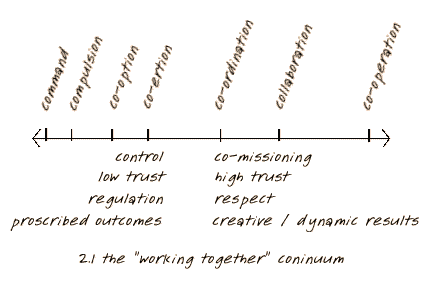|
Co-ordination, Collaboration and Co-operation — the challenges of working together |
|
From command to co-operation |
|
THE SECOND PICTURE I want to share here is a model I developed with Jan Francis during our work with the Local Employment Committees. It is a continuum, or a line, drawn to illustrate the different ways we can "work together".
On the left of the continuum you have people working together because they are told to. This extreme is where the motivation for group activity is "commanded" or "compelled". The line moves through the territory of "co-ertion" and "co-option" down to the right-hand side of the picture where we have "co-ordination", "collaboration", and "co-operation". On the left-hand side, the impetus for why we should be working together is because we are being ordered to — or it is part of our job description. The push for collective action is coming from outside of ourselves. On the right-hand side, we are working together for reasons which are more inwardly motivated. We have a much greater personal commitment to the mission of the group. This inward motivation leads to a greater understanding of the word commissioning. It literally becomes "co-missioning" as we bring together the goals and strategies of a variety of people and organisations ... allowing an overall mission to emerge. On the "command" side, the landscape for collective action is still very much a low-trust environment. There may be teamwork here, but there is also probably patch-protection and watching-your-back. On the "co-operation" end of the line, you can’t really operate unless you also have a high-trust environment — one which nurtures and develops the relationships between the diverse people involved. On the one side of this picture, the "outcomes" from your collective action are very much proscribed or regulated — you can list them, or count them — they may even be written into your contract. At the other end, the "outcomes" are not easily written down or counted. They are often serendipitous — emerging or "unfolding" out of the environment you have created. This is not to say that you don’t get "outcomes" from collaborative action ... they just don’t readily respond to lists or counts. In a co-operative environment, you shouldn’t be surprised if you get all sorts of creative and dynamic results that you never planned for in the first place. This continuum is also a picture of power. And here I am defining power as "the control of the choices." On the left-hand side, perhaps within an "in-charge" organisation, there is often a few players making all the choices, leading or dominating all the other participants. This may be simply excellent team work with a good captain — but it may also be a "bully culture" that just tells people to work together, or face the consequences. As you move across the line, the power moves to absorb or influence the choices of other players. When we arrive into the region of "co-ordination" and "collaboration", we start to see choices being made with respect to the other players. This respect involves showing consideration for the values and differences of the participating players. As we get to the other end of this continuum, we start to genuinely share choices, and talk about sincere partnerships. Next: Collaborative Leadership
|
